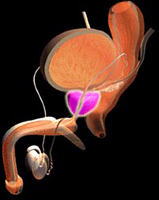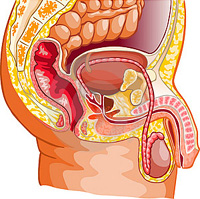How is the modern diagnosis of prostatitis in medical centers, which you need to pass the tests and how to put the right diagnosis «prostatitis»?
Content

Examination P
Rostats
Diagnose prostatitis is quite difficult. Symptoms peculiar to him may be caused by other diseases: infections of the urogenital system, who did not have time to affect the prostate gland, inflammation of the urethra or adenoma prostate gland. The localization of the pains of prostatitis can be taken for the intestinal dysfunction (colitis) or spinal pathology (osteochondrosis).
To eliminate errors related to extremely diverse and non-standard manifestations of chronic prostatitis, its diagnosis includes a thorough survey and examination of the patient, as well as a number of special research, including the finger test of the prostate gland and seminal bubbles through the rear pass (rectal survey).
Already an outdoor inspection of the area of the rear pass can identify changes that contribute to the occurrence of chronic prostatitis: hemorrhoidal nodes, cracks, inflammatory infiltrates (local seal and an increase in body tissue due to impregnation of its inflammation products).
Despite the rapid development of modern methods of diagnosis, the rectal finger study during chronic prostatitis did not lose its value and still remains one of the most objective diagnostic methods. The data of the primary direct finger rectal survey of the prostate (through the rectum) are the most valuable and reliable among the many existing prostatitis diagnostic criteria.
In this case, the examination is determined by the shape, borders and size of the prostate gland, the homogeneity of the consistency, the condition of the surface, the degree of pain. Palpation of the gland retains the leading value both for the primary diagnosis of prostatitis and for continuous monitoring.
With acute prostatitis, for example, during a rectal finger survey, a very sensitive, swollen, hot or solid prostate is detected.
However, even with the complete absence of palpatorially detected symptoms, the presence of prostate or prostatitis pathology. Therefore, special research methods are also applied, in particular laboratory and ultrasonicographic.
Special Prostate Research Methods
Laboratory research With prostatitis, it contributes to clarify the diagnosis and the choice of therapeutic tactics. The range of conducted studies is sufficiently diverse and includes a study of the secret of prostate, spermogram, a three-folded urine sample, a study of the pH-secretion of prostate, a study of urine obtained before and after massage of the prostate, bacteriological research of the secret of prostate, cytological examination of the secret, immunological research and much more.
Urine analysis (three-folded sample), Completed according to a special technique, can become a key point in the diagnosis of prostatitis. Certain portions of urine at the beginning, the middle and final phase of urination are collected in different dishes. Compared urine samples will show a source of infection that can be a urethra, bladder or prostate.
urine samples will show a source of infection that can be a urethra, bladder or prostate.
Cytological research Based on consideration under the microscope of the prostatic separated (secretion) of the gland. The prostatic discontinued doctor receives with the help of gland massage. The secret may contain mucus, pus and T. D. Analysis of the microscopic picture of the prostatic discharge allows you to judge the nature of changes in the gland.
Use ultrasONiographic diagnosis significantly simplified the diagnosis of prostate diseases, including its inflammation. With the help of ultrasound research, it is possible to identify structural changes in the prostate gland characteristic of chronic prostate. Purulent foci, prostate stones are clearly defined on echograms. Ultrasound Research allows you to distinguish chronic prostatitis from adenoma and prostate cancer. Despite the great advantages, ultrasonographic research is only an integral part of the complex diagnostics of prostatitis.
In some cases, there is a need for more complex studies. These include Vesiculography (X-ray study method of seed paths and seed bubbles), Study of protein blood fractions, Reovazography (testing of blood circulation in the gland), cystography (X-ray examination of the bladder), Ultrasonic and Radioisotope Iron Research, as well as Biopsy of prostate gland In the presence of indications. Sometimes chronic prostatitis detect when Sperm studies — The number of leukocytes increased in sperm.
Prostaty biopsy
Sometimes, mainly, if necessary, exclude the tumor nature of prostate infiltrates or with suspicion of tuberculous lesion of the prostate gland, biopsy is applied. Biopsy is performed using a special needle, through a rectal or crotch puncture. Biopsy in chronic prostatitis is mainly used to eliminate prostate infiltrate tumor nature.
Only a reliable and detailed diagnosis of prostatitis may be the basis for successful treatment. Only in this case can be hoped on the effectiveness of therapy. At the same time, the longer the inflammatory process in the prostate lasts, the more time the process of treatment of the patient occupies. Therefore, the duration of the disease in the diagnosis and treatment of prostatitis is of particular importance.
But the definition of the duration of the disease may be difficult because the gradual development of the symptoms of the disease causes patients to seek medical attention only at increasing not enough pronounced and not quite specific symptoms.
Diagnostic studies must be carried out periodically, since the course of prostatitis is usually unstable — He can exacerbate, complicate, and sometimes temporarily immortal.









